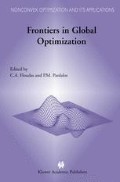Abstract
A classical problem in telecommunications is the determination of the extremal time congestion that can arise in a GI/M/N/N loss system with given arrival and service rates. A central difficulty was showing that a local extremum has to be global. The matter stood unresolved for many years but has recently been settled using quite delicate convex analysis. We treat this problem and some generalisations in a structurally simpler way by making use of quasiconvexity.
Access this chapter
Tax calculation will be finalised at checkout
Purchases are for personal use only
Preview
Unable to display preview. Download preview PDF.
References
Coyle A. J. (1989), “Sensitivity bounds in a GI/M/n/n system,” J. Austral. Math. Soc, Ser. B, Vol. 31, 135–149.
Coyle A. J. and Taylor P. G. (1992), “Bounds on the sensitivity of generalised semiMarkov processes with a single generally distributed lifetime,” Math. of Oper. Res.,Vol. 17, 132–147.
Coyle A. J. and Taylor P. G. (1995), “Tight bounds on the insensitivity of generalised semi—Markov processes with a single generally distributed lifetime,” J. Appl. Prob.,Vol. 32, 63–73.
Craven B. D. (1988), “Fractional Programming”, Sigma Series in Applied Mathematics, Vol. 4 Helderman Verlag, Berlin.
Dinkelbach W. (1967), “On nonlinear fractional programming,” Managt Sci., Vol. 13, 492–498.
Eckberg A. E. (1977), “Sharp bounds on Laplace-Stieltjes transforms, with applications to various queueing problems,” Math. of Oper. Res., Vol. 2, 135–142.
Peake M. and Pearce C. E. M. (2001), “On an extremal problem arising in queueing theory and telecommunications,” In Optimization & Related Fields, 119–134, Eds A. Rubinov & B. Glover, Kluwer, Dordrecht.
Peake M. and Pearce C. E. M. (2002), “On a convexity problem arising in queueing theory and electromagnetism,” In Differential Equations & Applications,Vol. 2, 149–158, Eds Y. J. Cho, J. K. Kim & K. S. Ha, Nova, Huntingdon.
Schaible S. (1978), “Analyse und Anwendungen von Quotientenprogrammen, Ein Beitrag zur Planung mit Hilfe der nichtlinearen Programmierung,” In Mathematical Systems in Economics, Vol. 42, Hein Verlag, Königstein.
Schaible S. (1981), “Fractional programming: applications and algorithms,” Euro. J. of Operational Res., Vol. 7, 111–121.
Schaible S. and Ibaraki T. (1983), “Fractional programming,” Euro. J. of Operational Res., Vol. 12, 325–338.
Sniedovich M. (1988), “Fractional programming revisited,” Euro. J. of Operational Res., Vol. 33, 334–341.
Stancu-Minasian I. M. (1997), “Fractional Programming: Theory, Methods & Applications”, Kluwer, New York.
Takács L. (1962), “Introduction to the Theory of Queues,” Oxford University Press, New York.
Author information
Authors and Affiliations
Editor information
Editors and Affiliations
Rights and permissions
Copyright information
© 2004 Kluwer Academic Publishers
About this paper
Cite this paper
Pearce, C.E.M. (2004). Quasiconvexity, Fractional Programming and Extremal Traffic Congestion. In: Floudas, C.A., Pardalos, P. (eds) Frontiers in Global Optimization. Nonconvex Optimization and Its Applications, vol 74. Springer, Boston, MA. https://doi.org/10.1007/978-1-4613-0251-3_22
Download citation
DOI: https://doi.org/10.1007/978-1-4613-0251-3_22
Publisher Name: Springer, Boston, MA
Print ISBN: 978-1-4613-7961-4
Online ISBN: 978-1-4613-0251-3
eBook Packages: Springer Book Archive

